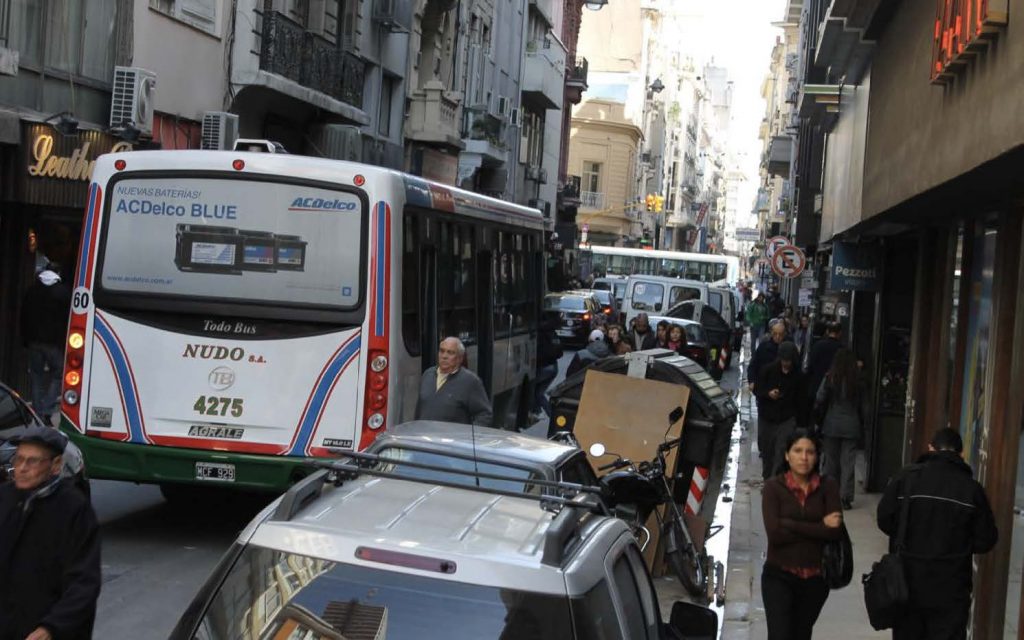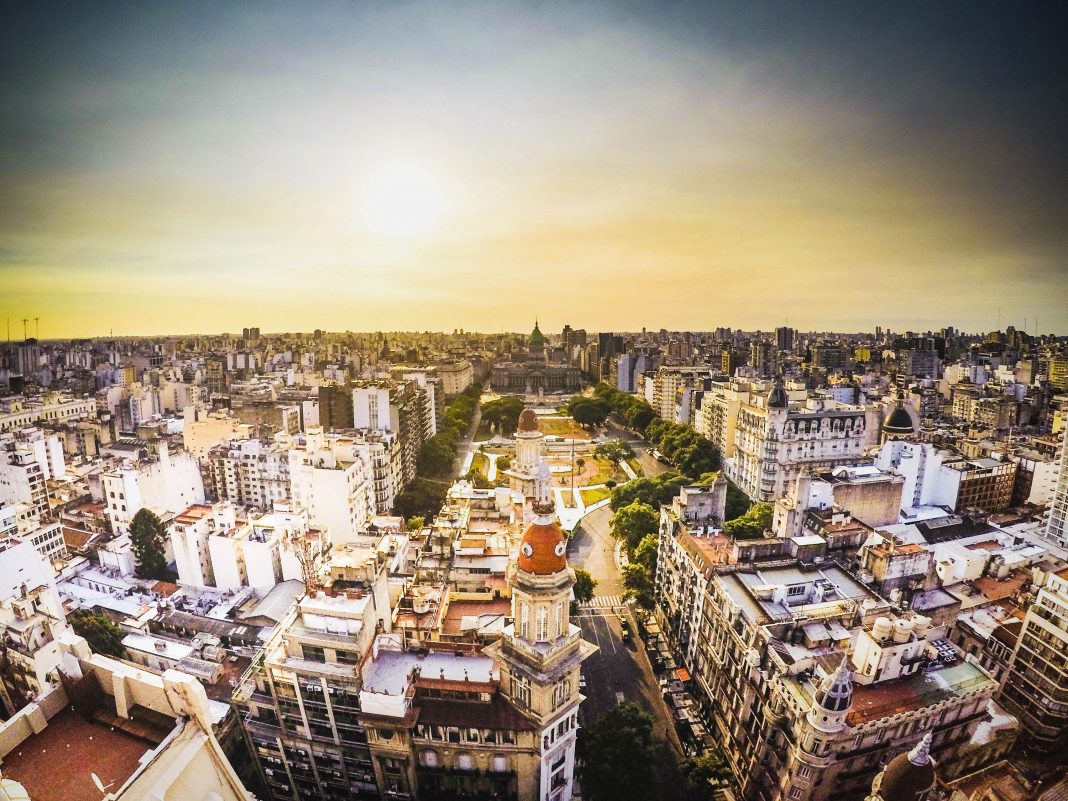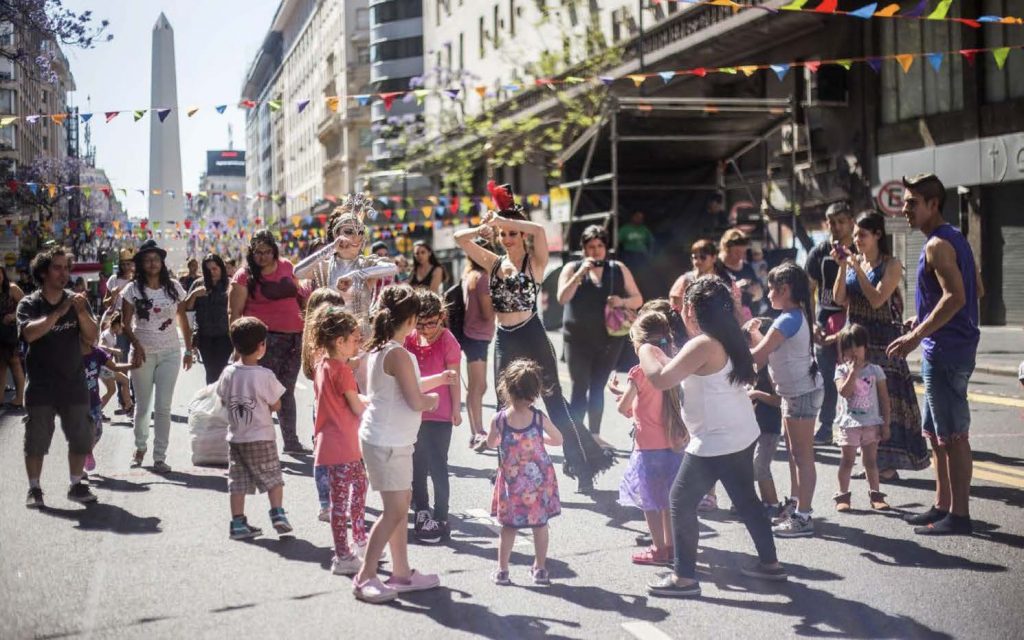Buenos Aires is home to around 3 million citizens (more than 15 million if you count the Greater Buenos Aires area). How relevant is walkability for a city of that size? We spoke to Clara Muzzio, minister of public space and urban hygiene for Buenos Aires, about the city’s metamorphosis to becoming more walkable, the challenges that it brings, and her proudest moment after shaping the city’s public spaces for more than ten years.
If you look at pedestrian advocacy in cities, you sometimes get the feeling that the topic is somewhat “too obvious” for politicians to get really engaged in – as if it was seen as a nice add-on, but nothing essential. An idea that Clara would challenge: “This has certainly not been the case in Buenos Aires. We have been investing in a human-centred city for many years now, which has progressively made it more walkable, human-scaled and enjoyable”, she says.
But how do you approach walkability efforts in a city of that size? Where do you start, and how do you get communities on board?
Starting Signal for Walkability Measures: Plan Microcentro
When asked about the start of walkability measures in Buenos Aires, Clara takes us back to 2011. The Plan Microcentro – Buenos Aires’ vision for the city centre – started to emerge, with Clara leading the adventure for the following years.
The historical, financial, and administrative centres, which she describes as the most chaotic and highly transited parts of the city with 2 million people accessing it daily, were transformed into a pedestrianised area with broader sidewalks and vehicle use restrictions.
Just to give you an impression: the Microcentro area covers 92 blocks on 1.4 km2, 13 subway stations from 5 subway lines, and 44 public bus lines. It’s a very dense area with administrative, commercial, cultural, and governmental activities.
Herculean efforts have been made in the fields of transit redesign, public space management, pedestrian priority areas, waste management, restoration of heritage buildings, and entertainment and boosting the economy.
Buenos Aires is following Jan Gehl’s “Cities for People” approach as a framework. For pedestrians this particularly refers to actions such as: quality maintenance and widening of sidewalks; installing a public biking system and additional bus stops; integrating information signs and urban furniture; updating facades; adding greenery (trees, green open spaces, green roofs); and giving space to food trucks, street art, and decks with tables and chairs.

Before: Clogged Streets in the City Centre 
Before: Car vs. Pedestrian Ratio

Before: Narrow Sidewalks in a Bad Condition 
Before: Visually Polluted Streets
One can imagine this to be a mammoth task – but a successful one. It kicked off a metamorphosis of Buenos Aires because seeing the successful completion of this project, and its popularity with pedestrians, led to implementing these kinds of changes in other parts of the city, too.

After: Redistributing Space to Pedestrians and Cyclists 
After: Closing Streets to Cars
“I remember that stage of my career with a lot of happiness and adrenaline. I was very young, and with my team of just ten people, we would go out into the city to survey the city centre’s 200 blocks to study how people experienced each of them and, based on that, design its transformation”, Clara happily recalls when thinking back.
Plan Microcentro paved the way for further measures to improve pedestrian infrastructure, which were continuously implemented over the past ten years. This was especially valuable during the handling of Covid-19: as restrictions started to ease, the city administration asked people to remain as local as possible, choosing to shop and pursue leisure in their neighbourhoods, going either by walking or bicycle, without travelling all the way to the city centre.
“We have been working in this direction since 2011. A clear example has been our work of expanding the area that restaurants and bars can use on sidewalks, including special decks and infrastructure, which meant they were well-positioned to re-open their open-air seating space by the time it was allowed. The walkability agenda was well developed, and it only required scaling it up by taking more space from cars to make sure people could respect social distancing while walking”, Clara explains.
What’s the biggest challenge with making a city more pedestrian-friendly, and what is most rewarding? According to Clara, it’s actually one and the same.
A Tale of Citizen Engagement: From Short-Term Frustration to Lasting Gratification
When it comes to the challenges of making a city more pedestrian-friendly, “the biggest challenge is engaging citizens to achieve cultural transformation”, Clara says. It’s especially car drivers that need to be convinced and need to be educated on why these interventions are necessary and beneficial for everyone. The overall message is clear: this is what the planet and the environment require from cities, making it our biggest driving force for changing our habits to be more human and sustainable.
This also goes for shop-owners and neighbours: an integral part of how Clara’s team understands the transformation process of the city is creating space to co-create with citizens. In these spaces, they foster participation and incorporate the needs and particularities of each specific area, which vary across the city.
“While when we first approach them to let them know about changes, some people may be weary, this tends to be related to the fact that they are used to things the way they are, whether it regards transit, their streets, or the structure of their neighbourhood, regardless of how chaotic it may be”, Clara explains. Other cities (and CityChangers, of course) can relate: humans are usually not first in line to embrace radical changes to their environments.
In Clara’s experience, this changes as soon as the processes are completed:
“After the transformation is completed, they are the first to express how happy they are with the changes, and to notice that by improving the walkability of the area there is more movement in the neighbourhood, more people enjoying it, which also increases sales and revenue in the case of shop-owners.”
Even if having these conversations might be difficult at first, don’t shy away. You have to open up to the community and spend time explaining your vision, and how it is following the direction that the world is heading in (with walkability, sustainable mobility and compact 15-minute city concepts taking over). Make sure that people understand that whatever commitment you made on paper will become a reality.
What was most surprising to Clara and her team throughout the process was the size of the impact among local traders and entrepreneurs and how much they got involved: “When you engage in these kinds of infrastructure improvements, we end up realising that the community gets much more involved than what you would imagine beforehand, making very valuable contributions and investing alongside the government”, she says.
So, Plan Microcentro was a major success – but is there anything that the city would do differently if they were to start over again?
Learnings From the Process: Five Key Take-Aways from Buenos Aires
In retrospect, there are a few things that Clara and her team noticed which can be useful lessons for other cities attempting an endeavour similar to Plan Microcentro. Here are her five key learnings from the process:
Political Backing and Leadership
Political will is an absolute must to deal with the negative aspects of the project, which are always there. Another relevant issue Clara took note of is the fact that, as a female leader, she was being a role model and dealing with expectations in male-dominated domains:
“As time passed by, I realised many times I mimicked men’s behaviours in negotiations because I thought that would lead to successful results. I now feel the responsibility, even if it is the longer road, to lead in a more authentic way. Being a woman in a position of power, I know I not only have to manage my ministry efficiently and achieve impact, but I also have a responsibility in contributing to reshape our culture and contribute to bridging the gender gap, and that includes rethinking what leading successfully entails.”
Don’t Overwhelm People
Avoid starting public works at several places at the same time. Pedestrians (everybody) will thank you! As Clara and her team got involved with large scale transformations like the Plan Microcentro, they learned to focus on planning interventions in sequences instead of causing major simultaneous shocks. This tends to reduce any transitory inconvenience public works may
generate for those that live or work near the site where construction is going on.
Data is Your Friend
Clara says that she has come to appreciate how valuable it is to document and generate data and evidence starting early on in projects: “We could have been better at that since day one, leading to more precise comparisons that allow us to evaluate the impact, and inform scalability of future projects as well as share best practices with other districts.” It is key to start as early as possible in the process, and it is something they’ve incorporated in all their efforts since.
Show Results As Soon As Possible
It’s not easy to show “quick wins” to people in large size projects but try to give them something as soon as you can. Split it into stages if needed, and don’t necessarily wait until all the work is done.
The Work is Done – Now What?
Finishing a project should not stop the ongoing process of engagement and collaboration. Work even closer with the private sector. Work shoulder to shoulder with all the stakeholders, the citizens, NGOs, etc. “Never stop improving your conversation with citizens,” Clara says, “as they are ultimately the users of everything that you are planning and doing.”
Clara’s Advice for CityChangers
Plan Microcentro kicked off a whole number of additional improvements in the city, including a Sidewalks Plan, with which Clara was able to improve and renovate half of the 320,000 sidewalks in the city. Having been involved in public space projects and processes for more than ten years now, Clara has a lot to look back on and be proud of.
Here’s her advice for both beginner cities and those that have advanced already:
“Firstly, take a leap of faith without wasting any time! If you haven’t yet made the adjustments the planet and the pandemic are demanding from us, the time is now. In the last year, so many people realised there is no alternative to adopting responsible consumption practices, which is changing so many personal habits. And they would be right to expect the same from those building and managing their cities. We work for them.”
She continues: “I also think it is important to approach urban transformation with an urban acupuncture lens: not every transformation needs to be massive in scale or resources. It is possible to make small and cost-effective yet very relevant actions in cities. You may not need a large budget to make transformations that matter to people and that improve their quality of life.”
While Clara acknowledges the challenges and obstacles that she had to face during her career so far, working with citizens has always been hugely rewarding for her:
“It is very moving and thrilling to realise people value the change you bring to their street and to their life. On so many occasions, elderly people have approached me telling me what a difference these transformations made in their ability to walk around the city without fear of tripping and falling, and how now they can enjoy walking again.”
Want to read more about Clara’s journey as a CityChanger and her vision for Buenos Aires? Head over to her CityChanger Portrait for more.




